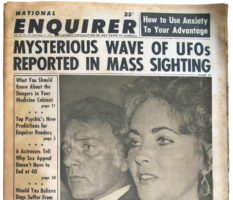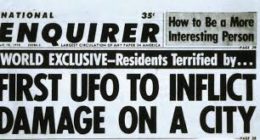by Charles Lear
 Stories of UFOs and aliens have long been associated with tabloid newspapers, often with ridiculous headlines, dubious claims, and photos that only the most credulous could take seriously. While these might be considered innocuous pieces of entertainment by many, for the serious UFO researcher they make it harder to convince a skeptical public that the subject is deserving of careful scrutiny. One of the most famous and long lasting of the tabloids is the National Enquirer, and while it might not be considered to be a bastion of journalistic integrity, it launched Bob Pratt, who was a staff reporter for the paper, into a lifelong occupation (not always paid) as a serious UFOlogist.
Stories of UFOs and aliens have long been associated with tabloid newspapers, often with ridiculous headlines, dubious claims, and photos that only the most credulous could take seriously. While these might be considered innocuous pieces of entertainment by many, for the serious UFO researcher they make it harder to convince a skeptical public that the subject is deserving of careful scrutiny. One of the most famous and long lasting of the tabloids is the National Enquirer, and while it might not be considered to be a bastion of journalistic integrity, it launched Bob Pratt, who was a staff reporter for the paper, into a lifelong occupation (not always paid) as a serious UFOlogist.
The National Enquirer began life in 1926 as The New York Evening Enquirer. It was founded using a loan from William Randolph Hearst, by a protégé of his, William Griffin. The paper became a place where pro-fascist and isolationist views were expressed in the years leading up to World War II, and the paper, along with Griffin, wasindicted in 1942 for sedition. The charges were later dropped.
With its circulation falling, the paper was bought in 1952 by Generoso Pope Jr., who turned it into the sensationalist tabloid with which most are familiar. Pope changed the name to the National Enquirer in 1957 and later became the first to get his tabloid placed in supermarket checkout lines in 1967. In order to do this, he replaced the stories of blood and gore which had originally increased the paper’s circulation, with celebrity news, tales of the bizarre, and UFOs. In 1971, the paper’s headquarters was moved to Lantana, Florida, and that was where Bob Pratt began working in 1973.
Pratt’s career in journalism began in 1951. He worked as an editor and reporter for several papers up and down the east coast from Buffalo, New York, to Florida. According to Pratt in “I’ve Never Seen a UFO, But…,” an article posted by Pratt on his website “The Bob Pratt Files,” he was skeptical of UFO stories to the point where he wouldn’t allow them to appear in print when he was “managing editor of a small daily newspaper in Virginia.”
Pratt began work with the National Enquirer as a writer. He stayed in that position for almost two years and then worked as a reporter for six and a half years. As a writer, he took stories from the reporters and edited them down from thousands of words to hundreds. Occasionally he would work on UFO stories, which he tells the reader he found “grating.” It was his opinion that the reporters weren’t asking the right questions.
 In 1975, when Pratt was working as a reporter, the editor he was working for inherited the UFO beat from another editor who had just been promoted. Pratt’s editor dropped ten files on his desk and told him to pick two.
In 1975, when Pratt was working as a reporter, the editor he was working for inherited the UFO beat from another editor who had just been promoted. Pratt’s editor dropped ten files on his desk and told him to pick two.
Pratt ended up picking only one file, but it seemed like it could turn out to be a good story. A family east of Superior, Wisconsin, reported a UFO landing near their farmhouse. Pratt called “half a dozen people” in the area and the claim took on more credibility. He was told that reports were still coming in of UFOs flying south along the St. Louis River and that some people felt there might have been a base at the bottom of the bay.
With the possibility of a headline like “UFO Base Found,” Pratt’s editor told him to go to Wisconsin and look into the story. He spent a week there, interviewed between 60 and 70 witnesses who reported sightings and encounters over the previous two years, and became convinced that there was a genuine mystery. According to him, the trip to Wisconsin changed his life, and he ended up “chasing UFOs ever since.”
Pratt took a particular interest in South American UFO reports and made five trips there while working for the National Enquirer, and more than a dozen trips on his own afterwards. He became fascinated with Brazilian encounters around the village of Colores, as most of the witnesses he talked to were terrified by their encounters to the point that they thought their lives were threatened. He wrote about his Brazilian investigations in his book “UFO DANGER ZONE, Terror and Death in Brazil –Where Next?” published in 1996 by Horus House Press.
The Colares encounters were part of a flap, from April 1977 into 1978, over the Amazon Delta in the northeast section of Brazil. Because it involved reports of attacks and injuries, the Brazilian Air Force was moved to put together a special operation to deal with it. It was designated “Operação Prato”, which is Portuguese for “Operation Plate.”
The most intense activity was concentrated to the north, around the village of Colares. Colares, then a village and now a city, is located on Colares Island. There, as with reports from elsewhere, glowing forms of all shapes and sizes were seen to come in from the north after nightfall. At times, creatures were seen occupying the UFOs, or associated with them. Villagers were so frightened, the women and children were sent away at night, while the men kept armed vigils.
The most disturbing aspect was that people reported being hit by beams of light that paralyzed them momentarily and left them feeling enervated afterwards. Men were left with burns on the neck and women with burns on the chest. Tiny punctures were seen in some of the burns. Some suspected that they’d had blood taken from them, and many villagers started calling the UFOs “chupas” or “chupa chupas.” Chupa means “to suck” in both Spanish and Portuguese.
Pratt stuck with the story up until the year of his death. He passed away on November 21, 2005, and in May of that year, the Brazilian Air Force announced that they were releasing declassified documents relating to Operação Prato at a meeting with UFOlogists at military headquarters in Brasilia. Pratt wrote a detailed blog in which he presented photos and documents, as well as background information and details of his own boots on the ground investigation.
Besides his involvement with the Colares case, Pratt did extensive investigation in New York’s Hudson Valley, where thousands of people, including law enforcement officials, reported seeing huge, football field-sized, boomerang-shaped craft in the early 1980s. He wrote about the case in “NIGHT SIEGE: The Hudson Valley UFO Sightings (Ballantine, 1987) along with Dr. J. Allen Hynek and Philip J. Imbrogno. Hynek, scientific consultant for Project Blue Book and founder of the Center for UFO Studies, died before the book was completed.
Pratt was a member of the Mutual UFO Network, and was editor of the MUFON Journal from 1983 to 1984. MUFON thought enough of him to include a pdf version of “The Bob Pratt” files on their website. He was also well thought of in Brazil, and at a conference in the city of Curitiba in southern Brazil on May 3, 2003, he was given a diploma naming him an “Ufólogo Brasileiro Honorário” signed by 78 Brazilian UFOlogists.
For a UFO skeptic who was forced into the field while working for a supermarket scandal sheet, Bob Pratt made quite an impact. Meanwhile, a recent search of the National Enquirer for articles on UFOs, revealed no indication that the publication was still paying its reporters to travel long distances to look into UFO stories. Pratt had a good gig there for awhile.
Fascinating story and biographical background on Bob Pratt who’s name I never heard before among the many UFO Investigators over the years. I’ve certainly read my share of Enquirer UFO stories when my grandmother brought them home from the grocery store always taking them with a grain of salt. Rarely did I recall the bylines because I thought they were non-consequential, written by a rotating gaggle of Monkees of no repute. Now you give a face an name to what appears to be a reputable man of substance and I have to take those old Enquirer stories in a different light now that I know a little bit about Bob Pratt.
Thank you Charles Lear!
Sincerely,
Michael J Schumann